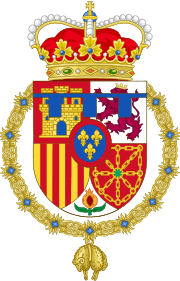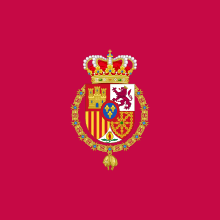Charles IV of Spain
| Charles IV | |||||
|---|---|---|---|---|---|
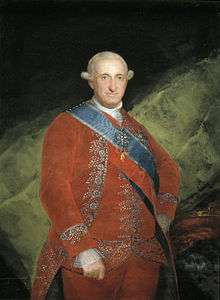 Portrait by Goya, 1789 | |||||
| King of Spain (more...) | |||||
| Reign |
14 December 1788 – 19 March 1808 | ||||
| Predecessor | Charles III | ||||
| Successor | Ferdinand VII | ||||
| Born |
11 November 1748 Palace of Portici, Portici, Naples | ||||
| Died |
20 January 1819 (aged 70) Palazzo Barberini, Rome, Papal States | ||||
| Burial | El Escorial | ||||
| Spouse | Maria Luisa of Parma | ||||
| Issue |
Carlota Joaquina, Queen of Portugal and Brazil Infanta María Amalia María Luisa, Queen of Etruria Ferdinand VII of Spain Infante Carlos, Count of Molina María Isabel, Queen of the Two Sicilies Infante Francisco de Paula, Duke of Cadiz | ||||
| |||||
| House | Bourbon | ||||
| Father | Charles III of Spain | ||||
| Mother | Maria Amalia of Saxony | ||||
| Religion | Roman Catholic | ||||
| Signature |
| ||||
Charles IV (Spanish: Carlos Antonio Pascual Francisco Javier Juan Nepomuceno José Januario Serafín Diego; 11 November 1748 – 20 January 1819) was King of Spain from 14 December 1788, until his abdication on 19 March 1808.
Early life
Charles was the second son of Charles III and his wife, Maria Amalia of Saxony. He was born in Naples (11 November 1748), while his father was King of Naples and Sicily. His elder brother, Don Felipe, was passed over for both thrones, due to his learning disabilities and epilepsy. In Naples and Sicily, Charles was referred to as the Prince of Taranto.[1] He was called El Cazador (meaning "the Hunter"), due to his preference for sport and hunting, rather than dealing with affairs of the state. Charles was considered by many to have been amiable, but simple-minded.[2]
Reign

In 1788, Charles III died and Charles IV succeeded to the throne. He intended to maintain the policies of his father, and retained his prime minister, the Count of Floridablanca, in office.[2] Even though he had a profound belief in the sanctity of his office, and kept up the appearance of an absolute, powerful monarch, Charles never took more than a passive part in his own government. The affairs of government were left to his wife, Maria Luisa, and his prime minister, while he occupied himself with hunting. In 1792, political and personal enemies ousted Floridablanca from office, replacing him with Pedro Pablo Abarca de Bolea, Count of Aranda. However, in the wake of the war against Republican France, the liberal-leaning Count of Aranda was himself replaced by Manuel de Godoy, a favourite of the Queen and widely believed to be her lover, who enjoyed the lasting favor of the King.
In 1799, he authorized Prussian aristocrat and scientist Alexander von Humboldt to travel freely in Spanish America, with royal officials encouraged to aid him in his investigation of key areas of Spain's empire. Humboldt's Political Essay on the Kingdom of New Spain was a key publication from his five-year travels.
Godoy continued Abarca de Bolea's policy of neutrality towards France, but after Spain protested the execution of Louis XVI of France, the deposed king, in 1793, France declared war on Spain. After the declaration, Portugal and Spain signed a treaty of mutual protection against France.[3] In 1796 France forced Godoy to enter into an alliance, and declare war on the Kingdom of Great Britain. As a consequence, Spain became one of the maritime empires to have been allied with Republican France in the French Revolutionary War, and for a considerable duration.[4]
Spain remained an ally of France and supported the Continental Blockade until the British naval victory at Trafalgar, when Spain became allied with Britain. However, after Napoleon's victory over Prussia in 1807, Godoy again steered Spain back onto the French side. This switching of alliances devalued Charles' position as a trustworthy ally, increasing Godoy's unpopularity, and strengthening the fernandistas (supporters of Crown Prince Ferdinand), who favoured an alliance with the United Kingdom.
Economic troubles, rumours about a sexual relationship between the Queen and Godoy, and the King's ineptitude, caused the monarchy to decline in prestige among the population. Anxious to take over from his father, and jealous of the prime minister, Crown Prince Ferdinand attempted to overthrow the King in an aborted coup in 1807.[5]
Abdications of Bayonne
Riots, and a popular revolt at the winter palace Aranjuez, in 1808 forced the king to abdicate on 19 March, in favor of his son.[5] Ferdinand took the throne as Ferdinand VII, but was mistrusted by Napoleon, who had 100,000 soldiers stationed in Spain by that time.
The ousted King, having appealed to Napoleon for help in regaining his throne, was summoned before Napoleon in Bayonne, along with his son, in April 1808. Napoleon forced both Charles and his son to abdicate, declared the Bourbon dynasty of Spain deposed, and installed his brother, Joseph Bonaparte, as King Joseph I of Spain.[6]
Later life and death
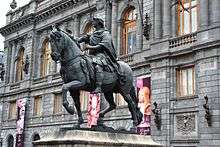
Following Napoleon's deposing of the Bourbon dynasty, the ex-King, his wife, and former Prime Minister Godoy were held captive in France first at the château de Compiègne[7] and three years in Marseille (where a neighborhood was named after him).[8] After the collapse of the regime installed by Napoleon, Ferdinand VII was restored to the throne. The former Charles IV drifted about Europe[9] until 1812, when he finally settled in Rome, in the Palazzo Barberini.[10][11][12][13] His wife died on 2 January 1819, followed shortly by Charles, who died on 20 January of the same year. Sir Francis Ronalds included a detailed description of the funeral in his travel journal.[14][15]
Character
Well-meaning and pious, Charles IV floundered in a series of international crises beyond his capacity to handle.[9] He was painted by Francisco Goya in a number of official court portraits, which numerous art critics have seen as satires on the King's stout vacuity.[16]
Marriage and children
Charles IV married his first cousin Maria Louisa, the daughter of Philip, Duke of Parma, in 1765. The couple had fourteen children, six of whom survived into adulthood:
| Children of King Charles IV | |||
|---|---|---|---|
| Name | Portrait | Lifespan | Notes |
| Carlos Clemente Infante of Spain |
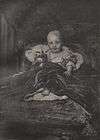 |
19 September 1771 – 7 March 1774 |
Born and died at El Escorial; baptized on the same day he was born, with Charles III representing "the Holy Father" at the christening. Pope Clement XIV celebrated Carlos' birth and sent the infant consecrated swaddling clothes.[17] |
| Carlota Joaquina Queen of Portugal and the Algarves |
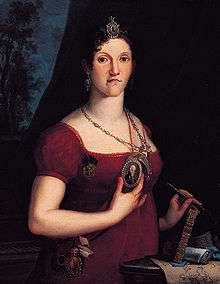 |
25 April 1775 – 7 January 1830 |
Born at the Royal Palace of Aranjuez, she married John VI of Portugal in 1785 and became Queen consort of Portugal in 1816. Had issue, including the future Pedro I of Brazil. She died at Queluz National Palace. |
| Maria Luisa Infanta of Spain |
_Version_with_Golden_Fleece_and_Order_of_Charles_III_Collars.svg.png) |
11 September 1777 – 2 July 1782 |
Born and died at the Royal Palace of La Granja de San Ildefonso.[18] |
| María Amalia Infanta of Spain |
.jpg) |
9 January 1779 – 22 July 1798 |
Born at the Royal Palace of Aranjuez, she married her uncle Infante Antonio Pascual of Spain in 1795. She gave birth to a stillborn son in 1798 and died shortly thereafter. |
| Carlos Domingo Infante of Spain |
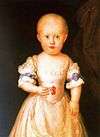 |
5 March 1780 – 11 June 1783 |
Born at the Royal Palace of El Pardo and died at the Royal Palace of Aranjuez.[18] After his birth, his father pardoned all of the convicts from Puerto San Julián as a sign of celebration.[19] |
| Maria Luisa Queen of Etruria Duchess of Lucca |
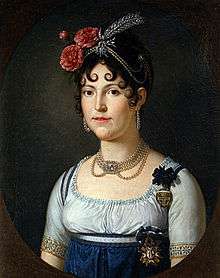 |
6 July 1782 – 13 March 1824 |
Born at the Royal Palace of La Granja de San Ildefonso, she married Louis, King of Etruria in 1795 and had issue, including Charles II, Duke of Parma. Became Duchess of Lucca in her own right in 1817 and died in Rome in 1824 of cancer. |
| Carlos Francisco de Paula Infante of Spain |
 |
5 September 1783 – 11 November 1784 |
Twins, born and died at the Royal Palace of La Granja de San Ildefonso.[20] Their birth was an important event for the people of Spain and provided security for the succession, a security which was truncated with the early deaths of Carlos and Felipe.[21] |
| Felipe Francisco de Paula Infante of Spain |
5 September 1783 – 18 October 1784 | ||
| Fernando (VII) King of Spain |
.jpg) |
14 October 1784 – 29 September 1833 |
Born and died at El Escorial, he succeeded his father as King in 1808, but was deposed by Joseph Bonaparte one month later. Married Princess Maria Antonia of Naples and Sicily in 1802, no issue. Re-instated as King in 1813. Married Maria Isabel of Portugal in 1816, had issue. Married Maria Josepha Amalia of Saxony in 1819, no issue. Married Maria Christina of the Two Sicilies in 1829 and had issue, including the future Isabella II of Spain. Died in 1833. |
| Carlos María Isidro Benito Count of Molina |
29 March 1788 – 10 March 1855 |
Born at the Royal Palace of Aranjuez. Married Infanta Maria Francisca of Portugal in 1816 and had issue. Married Maria Teresa, Princess of Beira in 1838, no issue. First Carlist pretender to the throne of Spain as "Carlos V". Use the title "Count of Molina" between 1845 and his death in 1855. | |
| María Isabel Queen of the Two Sicilies |
_by_Giuseppe_Cammarano_(Palace_of_Caserta).jpg) |
6 July 1789 – 13 September 1848 |
Born at the Royal Palace of Madrid, she married Francis I of the Two Sicilies in 1802 and had issue, including the future Ferdinand II of the Two Sicilies. Queen consort between 1825 and 1830, her husband's death. Died at the Palace of Portici in 1848. |
| Maria Teresa Infanta of Spain |
 |
16 February 1791 – 2 November 1794 |
Born at the Royal Palace of Aranjuez and died at El Escorial[22] of smallpox.[23] |
| Felipe Maria Infante of Spain |
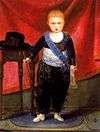 |
28 March 1792 – 1 March 1794 |
Born at the Royal Palace of Aranjuez and died at the Royal Palace of Madrid.[22] |
| Francisco de Paula Duke of Cadiz |
 |
10 March 1794 – 13 August 1865 |
Born at the Royal Palace of Aranjuez, he married Princess Luisa Carlotta of Naples and Sicily in 1819 and had issue. Died in Madrid in 1865. |
Ancestors
Titles and styles
- 11 November 1748 – 10 August 1759: His Royal Highness The Prince of Taranto
- 10 August 1759 – 14 December 1788: His Royal Highness The Prince of Asturias
- 14 December 1788 – 19 March 1808: His Majesty The King of Spain
- 19 March 1808 – 20 January 1819: His Majesty King Carlos IV of Spain (sometimes written Carlos IIII)[25]
Notes
- ↑ Almanach royal, p 34
- 1 2 Stanley G. Payne, History of Spain of Portugal, Vol 2,University of Wisconsin Press., 1973, ISBN 978-0-299-06284-2, page 415
- ↑ Portugal; de), José Ferreira Borges de Castro (Visconde; Biker, Julio Firmino Judice; Estrangeiros, Portugal Ministério dos Negócios (19 June 2018). "Supplemeto á Collecção dos tratados, convenções, contratos e actos publicos celebrados entre a corôa de Portugal e as mais potencias desde 1640". Imprensa nacional – via Google Books.
- ↑ Ollie Bye (3 February 2016). "The French Revolutionary Wars: Every Other Day" – via YouTube.
- 1 2 Payne, page 420
- ↑ Griffin, Julia Ortiz; Griffin, William D. (2007). Spain and Portugal:A Reference Guide from the Renaissance to the Present. Facts on File. p. 151. ISBN 978-0-8160-4592-1.
- ↑ Alain Raisonnier, Claudie Ressort (2009) Le séjour de Charles IV et de la Cour d'Espagne au Palais de Compiègne en 1808-1809, Annales Historiques compiégnoises, n° 113-114, pp. 14-24
- ↑ Paul Gaffarel (1919) Le séjour de Charles IV d'Espagne à Marseille, Revue des Etudes Napoléoniennes, t. XVI, pp. 40-57
- 1 2 Griffin, page 152
- ↑ fr:Charles IV d'Espagne
- ↑ Manuel de Godoy#Exile
- ↑ Worldroots.com Archived May 11, 2004, at Archive.is
- ↑ "The Royal Favorite: Manuel Francisco Domingo de Godoy, Prince of the Peace". www.napoleon-series.org.
- ↑ Ronalds, B.F. (2016). Sir Francis Ronalds: Father of the Electric Telegraph. London: Imperial College Press. p. 188. ISBN 978-1-78326-917-4.
- ↑ "Sir Francis Ronalds' Travel Journal: Naples and Pompeii". Sir Francis Ronalds and his Family. Retrieved 23 February 2018.
- ↑ Edward J. Olszewski (1999). "Exorcising Goya's "The Family of Charles IV"". Artibus et Historiae. 20 (40): 169–185. JSTOR 1483673.
- ↑ von Pastor, Ludwig Freiherr (1952). The History of the Popes, from the Close of the Middle Ages. Michigan: Kegan Paul. p. 201.
- 1 2 Real Academia Matritense de Heráldica y Genealogía (2007). Anales de la Real Academia Matritense de Heráldica y Genealogía. Vol. X. (in Spanish). Madrid: RAMHG. p. 330.
- ↑ Senatore, Mar'a Ximena (2007). Arqueolog'a e historia en la colonia espa–ola de Floridablanca, Patagonia, siglo XVIII (in Spanish). Madrid: Teseo. p. 149. ISBN 978-987-1354-08-5.
- ↑ Real Academia Matritense de Heráldica y Genealogía (2007). Anales de la Real Academia Matritense de Heráldica y Genealogía. Vol. X. (in Spanish). Madrid: RAMHG. p. 332.
- ↑ Palazón, Juan Manuel Abascal (2010). José Vargas Ponce (1760–1821) en la Real Academia de la Historia (in Spanish). Madrid: Real Academia de la Historia. p. 54. ISBN 978-84-15069-00-3.
- 1 2 Hilt, Douglas (1987). The Troubled Trinity: Godoy and the Spanish Monarchs. Alabama: University of Alabama Press. p. 292. ISBN 978-0-8173-0320-4.
- ↑ Zavala, José María (2013). La maldición de los Borbones (in Spanish). Mexico: Random House Mondadori. p. 16. ISBN 978-84-01-34667-5.
- ↑ Genealogie ascendante jusqu'au quatrieme degre inclusivement de tous les Rois et Princes de maisons souveraines de l'Europe actuellement vivans [Genealogy up to the fourth degree inclusive of all the Kings and Princes of sovereign houses of Europe currently living] (in French). Bourdeaux: Frederic Guillaume Birnstiel. 1768. p. 9.
- ↑ "1 Real - Carlos IIII, Chile". en.numista.com. Numista.
References
- Historia del Reinado de Carlos IV, by General Gomez de Arteche (5 vols.), in the Historia General de España de la Real Academia de la Historia (Madrid, 1892, etc.).
- Historiaantiqua. Isabel II; (Spanish) (2008)
External links
| Wikimedia Commons has media related to Charles IV of Spain. |


Charles IV of Spain Cadet branch of the Capetian dynasty Born: 11 November 1748 Died: 20 January 1819 | ||
| Regnal titles | ||
|---|---|---|
| Preceded by Charles III |
King of Spain 1788–1808 |
Succeeded by Ferdinand VII |
| Spanish royalty | ||
| Vacant Title last held by Ferdinand (VI) |
Prince of Asturias 1759–1788 |
Succeeded by Ferdinand (VII) |
